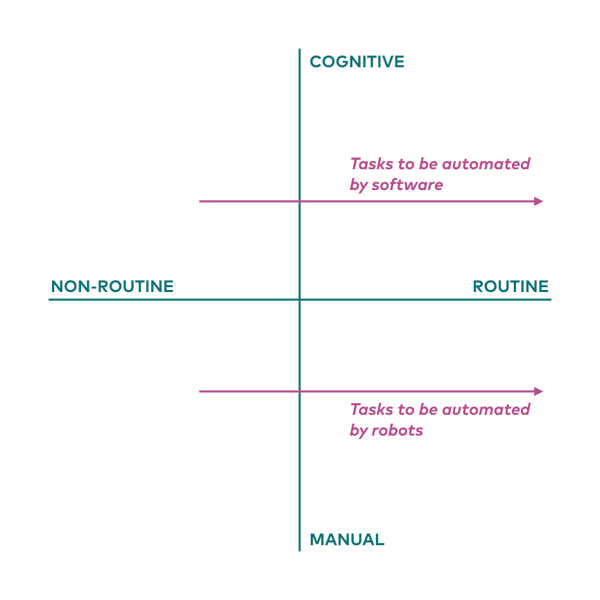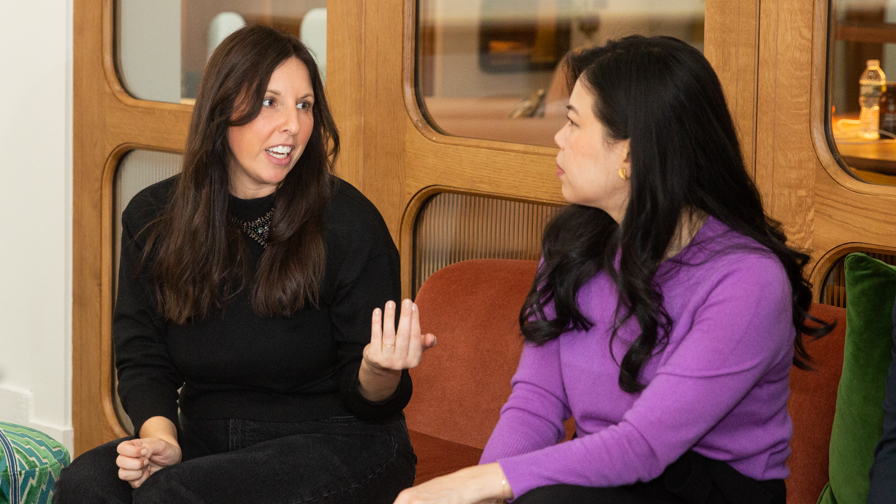Published February 26, 2019 | Updated August 17, 2024 | 5 minute read
How should leaders approach organization design as they navigate the shift to a more automated work environment?
Org design is hard. The scale of today’s global, matrixed organizations have made the exercise incredibly complex. Adding to this, acquisitions and mergers are on the rise. Figuring out how to combine businesses and integrate different company cultures can make the already daunting challenge feel impossible.
But, advances in technology demand that organizations continue to evolve if they want to continue to compete. While artificial intelligence might be in a slightly quieter phase of its hype cycle at the moment, it continues to advance at an astounding rate.
A recent Brookings Institute study estimates that in the 100 largest cities in the U.S., approximately 40-50% of jobs are susceptible to automation. And a recent McKinsey study found that almost half (47%) of the companies they surveyed have deployed at least one AI capability at scale, up from only 20% just one year ago.
Every business is sprinting to keep up with these advances, especially large global ones. And they have to if they want to deliver competitive value for customers, at competitive prices and costs, at scale.
This work of deploying automated solutions at scale is much more, however, than a matter of software installation. It impacts people and roles, processes, reward systems, organization structure and reporting, and even an organization’s purpose. In other words, the work of deploying AI at scale is the work of organization design.
Unfortunately, the established organization design frameworks and methods were created for a pre-AI world. Traditional approaches to organization design fail to account for the most fundamental aspect of AI-enabled organizations.
In their brilliant book The Second Machine Age, authors Erik Brynjolfsson and Andrew McAfee offer a simple way to understand where AI is most effective, and most likely to advance quickly.

Routine manual work – think manufacturing assembly line workers – is taken over by robots.
Routine cognitive work – think basic accounting – is taken over by software.
Related, but from the perspective of people instead of AI, in her brilliant book Teaming, author (and August Advisor) Amy Edmondson describes what she calls the “process knowledge” spectrum.

Different kinds of work, from the most routine and predictable to the least routine and predictable, require different approaches to leadership and teamwork to be successful.
These two perspectives on the intersections between the kind of work people do and the kind of work that AI can do have become foundational to how we think about organization design at August.
To simplify how to think about the work that exists inside your organization, consider this spectrum.

All work that you can think of can be placed along this spectrum. From the most routine tasks to the least routine. From the tasks where there is a well-known “right” way to do something to the tasks where the answers are complex and unknown.On the left, you have tasks like boxing widgets in a factory. In finance, think of basic accounting jobs. In legal, think of drafting standard agreements and form documents. In retail, think of inventory tracking. And if you’re running a global media agency, think of running and tracking ads.
On the right, you have exciting world-changing things like trying to cure cancer or inventing a self-driving car. But, you also have things like figuring out what will be the best new IT system to implement. What will be the breakthrough trend in our industry next year? How could we disrupt our own business model? How do we increase employee retention by 10%? What’s the best way to combine three offices and move our billing department to Chicago?

Most companies today are designed to operate really well at the certain, routine end of the spectrum. This is especially true of big global corporations, who excel at maximizing the benefits of everything that lives here.
Consider how your company is organized today. Think about how many roles and processes and rewards systems are designed to ensure that people do certain, predictable tasks the right way, over and over again, with minimal error. These are jobs waiting to be automated. And, unfortunately, the way most organizations operate have prioritized this kind of work in spite of the diminishing returns.

The competitive advantage of excelling at the certain end of the spectrum is quickly evaporating because that’s exactly the kind of work that computers are really good at. Computers excel at the most routine, most predictable tasks. So it’s no surprise that most companies are finding it harder and harder to create any unique value at this end of the spectrum. Computers create exponential value compared to humans doing the same tasks, and those new technologies become available to all your competitors nearly overnight, preventing any one company from gaining a unique advantage.

Meanwhile, human beings are really good at the least routine, most complex, most collaborative, most creative work. And we’re much better than computers at this stuff (at least for now…). This is the stuff that’s hard for computers.And this is where teams and organizations of human beings — working together toward a shared goal — can create massive value.This is where the world-changing happens.But, sadly, most organizations are optimized for certainty, when they should be optimized for uncertainty.Optimizing for uncertainty looks different, and it’s what allows organizations to thrive in the face of constant change.
So as companies undertake major automation initiatives, hoping to reap the benefits of AI, they should be thinking about how their new organization design will enable them to reap the benefits of human creativity and innovation at the uncertain end of the spectrum.
Traditional approaches to organization design fail to account for the most fundamental aspect of AI-enabled organizations:
The biggest opportunity created by implementing AI at scale is not the cost reductions and efficiencies (although they’re great, too), but rather the new levels of human creativity and innovation you can unlock.
To unlock this potential, however, you need an approach to organization design that is optimized for uncertainty. You need an approach that puts transparency, iteration, and participation at its core. In our work, we apply three key principles to organization design:
Open – Make it as easy as possible for people to access the information they need to be successful. This means that as org design choices are made, they need to be documented and shared in open, digital cloud-hosted formats that people can access on their own, instead of forcing people to figure out which leader has the latest PPT file – “You know… the updated one with the dotted line between Karen and Sarah…” – on their hard drive.
Learning – Assume that whatever design we come up with will be imperfect, and make it easy to quickly sense what’s working and what needs to change. Lean and Agile aren’t just for product and software development. The same cyclical approach of prototyping, testing, learning, and iterating can and should be applied to org design.
Network – Make it easy for people to contribute to your org design, regardless of who they are or their position in the current organization. No group of “experts” has ever come up with an org design that adequately predicted and accounted for all of the possible variations and unique needs of the people closest to customers and closest to the work, especially at scale. Plan to turn this huge network of sensors into an asset by building in systems and processes to hear and integrate improvements to the org design as they emerge.
This is how you design an organization that is built to adapt and evolve, continuously. And, importantly, this is how you design an organization that harnesses the potential of artificial intelligence while also unlocking the potential of human intelligence. This is how you design an organization that creates true competitive value by enhancing creativity, collaboration, and innovation at scale while also enhancing efficiency, speed, and costs.


.jpg)






